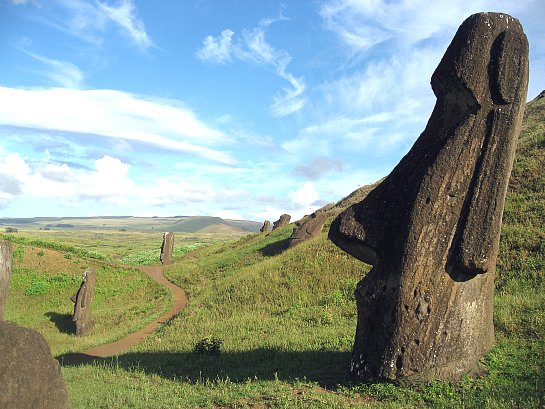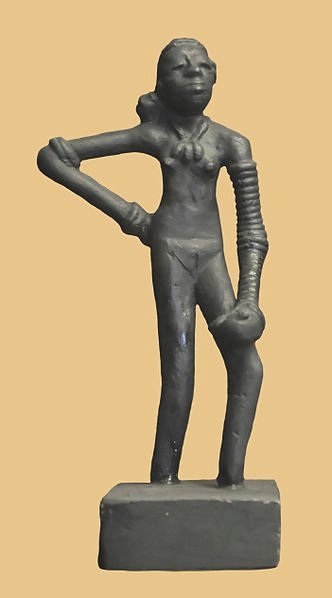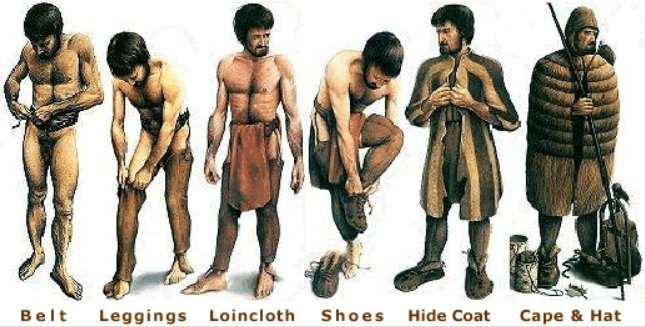SCISSION VII - EVOLUTION: FROM PRIMITIVISM
TO ???
These days we congratulate ourselves on having traveled a long road
from living in caves to climate-controlled living, powered automobiles
whisking us from place to place faster than Cinderella's carriage,
world-wide air travel and even space travel. Such a view is reinforced
by Arthur C. Clark's stirring beginning in his film '2001'. But even
Clark's conception of a primordial obelisk amongst the evolving apes
seems to hint at some sort of an advanced ancient culture.

Mike Adams and
Dan Berger
conceptualize the
impact of modern
technologies with
humor
As children we saw pictures of primitive societies, scantily clad [at
best] natives, various forms of body-enhancement evident on them as
they danced and chanted to rhythmic drums. We somewhat came to think of
'primitivism' as nudity, body painting, body piercing, tattoos, wild
hair styles, simplistic chants accompanied by repeating drum beats...
tribal unity. These things represent the glorifying of the flesh,
something that we fancy that we have evolved beyond.
Yet since World War II we have seen an acceleration to embrace all of
these same 'primitive' characteristics. Before WWII women's bathing
suits had short legs and sometimes short sleeves and covered everything
from the neck to about the knees. After the War era women's bathing
suits were reduced to just covering the torso; then they were reduced
to the 'bikini'. Recently nude bathing is becoming the norm in various
places.
Male hair styles evolved from 'military style' to 'DA-s' to page-boy to
below shoulder length and more recently 'punk' styles with vertical
spikes and wild coloring. Conversely, women have been cutting their
hair shorter and shorter until some women recently have little to no
head hair at all.

Mel Gibson in the film Braveheart
depicting the Scot wearing woad;
image taken from Wikipedia.
In Mel Gibson's 1995 film, 'Braveheart', portraying the 13th century
Scottish patriot Sir William Wallace, the Scot is portrayed with body
paint [woad] on the face. This presumably depicted an older Celtic
cultural practice. In earlier times when Rome battled the Celts they
noted body tattoos and body painting1|. Julius Caesar describes
tattooing among the Picts of northern Scotland in Book V of his Gallic
Wars2| (54 BCE). Certainly we know that the American Indians were
greeted wearing 'war paint' in Colonial times and following.
Such body enhancements were not limited to the males. PBS portrays
Boudica, the first century British rebellious warrior-princess of the
Celtic Iceni Tribe, with face paint3|. Her victory over the Roman
legions was described as 'barbarian cruelty'. The 2003 film titled with
her name also depicts the 'Warrior Queen' with face and arms painted.
Tattooing has been practiced at least since Neolithic times. This is
evidenced by the finding of the 'Ötzi Iceman' [see below] found in a glacier in the
Ötzal Alps on the borders of Austria and Italy. The mummy is believed
to be dated to about 3,300 BCE4|. His ice-preserved flesh shows about
57 tattoos, some on his spine, some behind the left knee and some on
his right ankle.
It is believed that tattooing was popularized in Western culture
through circumnavigation to Polynesia in the Age of Exploration;
European sailors picked up the practice and transported it back home5|.
In fact the Oxford English Dictionary attributes the etymology to
deriving from Polynesian tatau6|.
While historical documentation is sparse concerning body piercing, it is almost
certain that the practice has existed with both sexes since
pre-historic times. The 5,300 year-old Ötzi the Iceman mentioned above
had his ears pierced. Earrings from about 2,500 BCE have been found in
graves from Sumerian Ur. In the Bible, Genesis 35:4 mentions Jacob
burying 'earrings' [Hebrew nezem, which also denotes nose rings] under
the Oak of Shechem [about 1,700 BCE]. There are reports that earrings
were common in the Eighteenth dynasty of Egypt, from 1550–1292 BCE7|.
The Indian Vedas refer to nose piercings about 1,500 BCE8|. The Aztec
and Maya of Mesoamerica pierced their noses in order to wear bones as
well as gold rings indicating status and virility9|.
Lip and tongue piercing is harder to document since historical human
remains usually do not include these parts of the body. In more modern
times the practice is observed among the peoples of Papua New Guinea
and Amazonia. In Ethiopia women of the Mursi wear lip rings on occasion
that enlarge the lower lip to a disk nearly 6 inches in diameter. The
Easter Island Moai statues have elongated ear lobes, presumably from
weighty ornaments attached thereon. The ancient Mexican indians, the
Olmec [1500 to about 400 BCE] are said to have pierced the tongue for
ritual purposes10|. The Olmec and Maya are said to have pierced the
tongue and penis to obtain blood for ritual purpose11|.

Easter Island
Moai statue
with elongated
ears visible.
Navel, nipple and genital piercing is also difficult to document in
ancient times. The Indian Hindu text, Kama Sutra, dated approximately
2,000 years ago, mentions piercing the foreskin of the penis for pins
in order to enhance sexual performance12|. Roman soldiers reportedly
pierced their nipples in order to hang certain garments13|, although
there is cause to doubt this.
The Celts were also noted to be huge lovers of wine. Diodorus Siculus,
Greek historian of the first century BCE, writes that they were
extremely addicted to wine and that one could purchase a slave for a
mere jar of wine. He writes, '[they] fill themselves with the wine
which is brought into their country by merchants, drinking it unmixed,
and since they partake of this drink without moderation by reason of
their craving for it, when they are drunken they fall into a stupor or
a state of madness14|.'
Cuthbert, the Archbishop of Canterbury, was addressed in the eighth
century by Saint Boniface who pointed out, 'In your diocese, the vice
of drunkenness is too frequent. This is an evil peculiar to pagans and
to our race. Neither the Franks nor the Gauls nor the Lombards nor the
Romans nor the Greeks commit it [sic]15|.'
Joseph Jordania, styled as an Australian-Georgian ethnomusicologist and
evolutionary musicologist, has gone as far as to state that natural
selection favored body painting, dancing, loud group singing, rhythmic
stomping and drumming on external objects; he identifies these
activities as the means to reach the specific altered state of
consciousness - battle trance - through the ritualized activities.
Jordania believes that group members of these activities lose their
individuality and assume a shared collective identity; they lose the
feel of fear and pain and become fully dedicated to the group interests.
Today body painting, or 'body art', has come back into vogue. Fans at
NFL football games as well as other popular sports paint themselves in
the team colors, often baring their chests as well as their faces. Some
lament that modern body painting 'includes many sensationalist and
exhibitionist forms16|.' The practice is reputed to have been
established in modern popular culture by a Vanity Fair Magazine cover
featuring actress Demi Moore on its cover in August of 199217|.
However, French artist Yves Klein initiated an alternative art movement
in the 1950s and 1960s involving covering a model in paint and then
having the model roll on a canvas to transfer the paint, creating
interesting effects.

World Bodypainting Festival;
Artist: J. Fusilier & L. Hammel;
Photo: Michael Genswaider.
Picture taken from Wikipedia.
The practice is raised to an art form by such international festivals
as the World Bodypainting Festival in Pörtschach in Austria. There are
similar events in America at Nanaimo, British Columbia, Orlando,
Florida and Las Vegas, Nevada. The Painted Alive Gallery on Royal
Street in the French Quarter of New Orleans features many artistic
examples of body painting18|.
Wrestling on televison has helped to spread body painting as an
accepted form of expression. Of course face and body painting by the
military as 'camoflage' has become well known since WW II as troops
are trained to fight in remote areas of the world.
Face painting has become a popular form of expression, extending even
to early youths; most juvenile expressions are done in temporary
water-soluble paints. Entrepreneurs offer their talents at fairs and
theme parks in Western cultures.
Apparently the myth propagated in the James Bond film Goldfinger, that
covering the whole body with paint results in asphyxiation, has been
disproven19|.
Similar to body painting but more permanent is the ancient practice of
tattooing. The term 'tattoo' is believed to have been brought into
Western culture by the naturalist, Joseph Banks, a naturalist aboard
Captain Cook's ship the HMS Endeavour. He remarked that the natives of
the Pacific South Sea Islands mark themselves indelibly 'in different
parts of his body according may be to his humour or different
circumstances of his life20|.'
 'Jesus is So Cool' matching Christian tattoos
kris krüg from Vancouver, Canada
[taken from above link]
'Jesus is So Cool' matching Christian tattoos
kris krüg from Vancouver, Canada
[taken from above link]
Television has played a part in America poularizing tattos with such
shows as A&E's Inked and TLC's Miami Ink and LA Ink. Singer Janis
Joplin was an early tatto exhibitionist with two tattoos, a wristlet
and a heart.
Tragically, tattooing has been used for identification in the past
century, especially by the Nazis in Germany for concentration camp
resettlements. In 787 CE the Second Council of Nicaea banned all body
markings as a pagan practice; this probably set a tone of resistance to
such practices that has survived unto today.
Body Piercing
Similar to other body-enhancements, body piercing has been in a
resurgence since WWII, discounting the popularity of ear piercing by
women. Whether such a choice represents an individual's desire to
confirm or rebel seems to depend on the specific situation or
individual. Resistance has been raised by schools, religious groups and
some employers.
One three volume study states that the rise of body piercing following
WWII was due to the 'gay' male subculture23|. Fakir Musafar (born
Roland Loomis) initiated a 'Modern Primitivism' movement that promoted
piercings24|. His unconventional views concerning a return to primitive
behaviors have been widely promoted in popular media for over a decade.
Some current body piercing groups, as well as 'primitive' and other
body enhancements, have been confronted by the law for sadomasochistic
'crimes'. Despite mounting an unsuccessful defense, the court cases
have drawn much popular attention.
In the United States piercing has grown and includes piercings of the
navel, nose, eyebrows, lips, tongue, nipples and genitals25|. In
England over 46% of women youth between 16 and 24 years of age have
piercings other than ear lobes26|. A recent cultural study shows that
individuals with body piercings are more likely to be involved in other
counter-culture expressions27|.
Many employers, such as Walt Disney Parks and Resorts, prohibit any
display of piercings.
Primitive? Hairstyles
It is rather subjective to identify hair styles that are primitive
because showy styling has been a phenomenon over many cultures and many
ages. Still, there are certain 'post-modern' hair styles that would
immediately spring to the average mind today.
A somewhat recent style is known as 'spikes' or 'Liberty Spikes'. It may have no primitive precursor but it certainly draws
attention as 'reactionary'.
Another is called the 'Mohawk' and certainly is reminiscent of
Colonial American Indian styling.
 The Psychobilly Wedge is said to resemble the Mohawk but is also
related to the older Elvis Presley pompadour.
The Psychobilly Wedge is said to resemble the Mohawk but is also
related to the older Elvis Presley pompadour.
The rattail, somewhat like the ponytail, is a long thin braid or
curl starting at the top of the neck; the rest of the head is trimmed
very short. It vaguely reminds this author of some European sailors of
about the eighteenth century.
Cornrows,
which are braids that can run horizontally or
vertically or in intricate patterns, said to have originated in Africa
and become popular among African Americans; however, the style has also
taken root in a wider population. Waves is somewhat similar but without
the braided dreadlocks hanging down.
As stated, hairstyles have perennially been both cultural and
counter-cultural expressions. The examples above are really a short
sampling of 'post-modern' styles.
Dance as Culture
Dance can be characterized generally as moving the body to a rhythmic
cadence or music. In 1926 a stunningly beautiful bronze statuette just
a little over 4 inches high named 'The Dancing Girl' was discovered in
the ancient Indus Valley civilization city of Mohenjo-daro. It is dated
to be about 4,500 years old.

Replica of 'Dancing Girl'
of Mohenjo-daro at
Chhatrapati Shivaji
Maharaj Vastu
Sangrahalaya in
Mumbai, India.
Joe Ravi
Ancient cave paintings show humans leaping over and around probably
somewhat tamed animals. Some cave paintings display hunting and even
warfare, all with very active body movements indicated. One example is
found at Toca da Entrada do Pajaú [Serra da Capivara], Brazil, a site
with the highest number of rock paintings in the world28|. One of the
9,000 - 30,000 year-old rock paintings of Bhimbetaka, India, pictures
group dancing29|.
Obviously the need of humans to express themselves in dance form
predates recorded history - as well as using the display arts to remind
people of those activities. Most likely dance was created from earliest
times around fairly normal activities such as hunting and other demands
for prowess - that is 'interpretive'. As such, dance could be described
as 'communication', and that from the time of primitive humans.
Primitives in Brazil's rainforest and Africa's Kalihari Desert use
dance to create ecstatic states for the purpose of healing30|.
One list of the names of dances from all of history all over the world
contians well over 600 entries. These generally fall into three
categories: solo dance, partner dance and group dance. Such a list
makes it somewhat difficult to differentiate between 'classical' [or
'performance'] [ballet, ballroom, etc.] and 'popular' dancing [hip hop,
twist, etc.]
Still, some dances harken back to earlier times. There were stories
around the turn of the 21st century of dancers attaching razor blades
to their clothing and dancing free-style, cutting each other with the
sharp razor edges. This author has not found any of these news stories,
but there appears to be some sort of 'cultish' attraction to blood and
dancing in evidence on the internet31|. I Kings 18:26 et fol. states:
And they took the bullock which was given them, and
they dressed it, and called on the name of Baal from morning even until noon, saying, O Baal, hear
us. But there was no voice, nor any that answered. And they leaped upon the altar which was made. 27
And it came to pass at noon, that Elijah mocked them, and said, Cry aloud: for he is a god; either he is
talking, or he is pursuing, or he is in a journey, or peradventure he sleepeth, and must be awaked. 28 And
they cried aloud, and cut themselves after their manner with knives and lancets, till the blood
gushed out upon them.
Breakdancing, or 'breaking', is said to derive from a popular slang
term meaning 'getting excited', 'acting energetically' or 'causing a
disturbance'. Some have likened 'b-boying' as related to the martial
arts, referring back to the movement found in the Brazilian martial art
capoeira which came about in the 1500's. Others reject that comparison
and liken the movements to James Brown and Kung-Fu films as influences
instead32|.
Perhaps it is unfair to draw the comparison, but this author, when he
sees 'breakdancing' is reminded of Mark 9:19 and 20:
19 He answereth him, and saith, O faithless
generation, how long shall I be with you? how long shall I suffer you? bring him unto me. 20 And they brought
him unto him: and when he saw him, straightway the spirit tare him; and he fell on the ground, and
wallowed foaming. . . . 26 And the spirit cried, and rent him sore, and came out of him ...
Also Mark 5:1 et fol.:
. . . into the country of the Gadarenes. 2 And when
he was come out of the ship, immediately there met him out of the tombs a man with an unclean spirit, 3
Who had his dwelling among the tombs; and no man could bind him, no, not with chains: 4 Because
that he had been often bound with fetters and chains, and the chains had been plucked asunder by
him, and the fetters broken in pieces . . .
Which is not to suggest that these performers are 'possessed', but only
that their performance may remind one of such Biblical passages.
Breakdancing, or breaking, may also harken back to those types of
dancing which engendered ecstatic states of mind.
Naturism or Nudism
It would seem almost obvious to rank nudism as primitive behavior; but
is it, really? From a Darwinian point of view we would ascribe lack of
covering to apes. However, it seems likely that primitive man was more
likely to cover their skin, both for protection from the elements and
also as protection from injury, especially from predators.

In 1991 the mummy of 'Ötzi
the Iceman' was found in the Ötztal Alps [in the state of Tyrol, Austria / Italy], dating
to perhaps 3300 BCE. Some
of his clothing and other artifacts were discovered
with the mummified body.
Nudity as a recorded public practice can be traced back at least to the
Classical Greek games or sports. Nudity among men in public displays
and art was more common than nudity with women. Frescoes of Minoan
youth show them in sports wearing only a bikini-type girdle below their
waist. The word 'gymnasium' comes from the Greek and means 'a place to
train naked' from the Greek gymnos 'naked'.
Apparently homosexuality was not uncommon in ancient Greece. Alexander
the Great was reputed to have taken male lovers, especially his cavalry
commander, Hephaestion, although the evidence is not clear. He did
reject offers of male boys with indignation. Alexander married three
times and had children.
The Seleucid Emperors of Palestine two centuries before Christ
instituted nude sporting contests, much to the chagrin of many Jews.
Later Rome followed Greece's practice sparingly in sports and public
bathing.
Drawings in ancient Egyptian tombs show nude dancers; supposedly
Egyptian children went naked until puberty33|. Isaiah 20:4 states: So
shall the king of Assyria lead away the Egyptians prisoners, and the
Ethiopians captives, young and old, naked and barefoot, even with their
buttocks uncovered, to the shame of Egypt.
During the Industrial Revolution the attitude in Europe and America
seemed best characterized by the term 'Victorian'. In 1924 a group
known as 'Down with Shame' in the new Soviet Union conducted nude
marches in an effort to overcome 'bourgeois' morality. However, for the
1912 Stockholm Olympics a poster showing nude male athletes, in the
ancient Greek tradition, was censored in some countries.
One current manifestation of public nudity is the practice of
'streaking' nude at large stadia sports events.
Surveys conducted in the United States indicate that between 72-80% of
those surveyed believed that nude bathing and nude congregation should
be unrestricted by government as long as it is done in accepted
areas34|. Similar surveys in Great Britain show that over 55% of the
populace has had some experience with a naturist club35|.
The establishment of 'naturist camps' and communal nudist activities
has given rise to a tourist industry widespread around the world, from
Croatia and Slovenia to Nambassa, New Zealand. A 'World Day of
Naturism' has been established by the International Naturist Federation
as the first Sunday of June.
Naturism - communal nudity - has found critics both in the law and in
religion. One great complaint is that such communal exposure leads to
eroticism and promiscuity.
The need to protect themselves from intrusion or undue public exposure
has led many naturist groups to assume an identity of 'family'.
- - - - - - - - - -
It would obviously be a point of contention whether these above
expressions link back in history to more primitive types of behavior.
At the beginning of this scission we mentioned the opening of Arthur C.
Clark's film where a stone monolith amongst a group of apes suggested
that perhaps there were prehistoric civilizations. It is telling that
at the end of Clark's film we see the return of the primordial obelisk,
perhaps to remind us that we are still 'primitives'.
—————————————————————————————————
[All web links acquired in Summer
of 2014]
1| http://ancientmilitary.com/celtic-warriors.htm
2| Julius Caesar, The Gallic Wars, Book 5, Chapter 14; Translated by W.
A. McDevitte and W. S. Bohn;
read at: http://classics.mit.edu/Caesar/gallic.5.5.html
3| http://www.pbs.org/wgbh/masterpiece/warriorqueen/
4| Richard Owen, Mummified soldier found in Italian Alps, The [London]
Times, 26 August, 2010.
5| ( tattoo )
6| Origin: mid 18th century: from Tahitian, Tongan, and Samoan ta-tau
or Marquesan ta-tu
http://oxforddictionaries.com/definition/tattoo--2?region=us&q=tattooed
7| Jon Manchip White, Ancient Egypt; Its Culture and History; Courier
Dover Publications; (1970)
8| Elayne Angel, The Piercing Bible: The Definitive Guide to Safe Body
Piercing; The Crossing
Press; (2009).
9| Rayner W. Hesse, Jewelry making through History: an Encyclopedia;
Handicrafts Through World
History; Greenwood Publishing Group; p. 26;
(2007).
10| Ibid.
11| Rosemary Joyce, et al, 'Olmec Bloodletting: An Iconographic Study',
in Sixth Palenque Roundtable,
ed. V. Fields, University of Oklahoma Press,
Norman, Oklahoma; (1991).
12| Elayne Angel
13| Bonnie B. Graves, Tattooing and Body Piercing: Perspectives on
Physical Health; Capstone
Press; (2000).
14| The Library of History of Diodorus Siculus, published in Vol. III
of the Loeb Classical Library
edition, 1939, Book 5, Chapter 26. Also
see:
http://penelope.uchicago.edu/Thayer/E/Roman/Texts/Diodorus_Siculus/5B*.html
15| Tristram Hunt, We're still failing history; The Guardian, The
Observer, Saturday 27 August, 2005.
also see at:
http://www.guardian.co.uk/politics/2005/aug/28/immigrationpolicy
16| http://www.visual-arts-cork.com/painting/body.htm
17| Shawn Sell, Demi Moore, painted lady, USA TODAY; Monday, July 6,
1992; see Vanity Fair cover
at;
http://en.wikipedia.org/wiki/Demi's_Birthday_Suit
18| http://www.craigtracy.com/gallery.html
19| Prof. Metin Tolan, James Bond im Visier der Physik.m4v -- see at:
http://www.youtube.com/watch?v=talpnP46I30 [German]
20| The Endeavour Journal of Sir Joseph Banks, [entry] after 14 August
1769; read at:
http://gutenberg.net.au/ebooks05/0501141h.html
21| Brittany Stack, 'I'm inked therefore I am: Why tatts have left a
mark on Gen Y'; The Sunday Telegraph,
October 31, 2010
22| Nick Groom, 'The Union Jack: The Story Of The British Flag';
Atlantic Books, London; (2006)
23| Amanda Porterfield [Foreward], 'Religion and American cultures: an
encyclopedia of traditions,
diversity, and popular expressions'; ABC-CLIO,
p. 356; (2003).
24| Fakir Musafar, 'Spirit + Flesh'; Arena Editions; (2004)
[if you have the stomach]
http://www.bodyplay.com/
25| Op cit.
26| Bone, Angie, et al, "Body Piercing in England: a Survey of Piercing
at Sites Other than Earlobe";
BMJ Publishing Group Ltd 336 (336): 1426–1428;
(21 June 2008).
27| Lisiunia Romanienko, 'Body Piercing and Identity Construction', pp.
33–50, 131–139; Palgrave
Macmillan; (2011).
28| Stone Wall Paintings of Prehistoric Brazil; see at:
http://brazilinhotpants.wordpress.com/2011/02/21/stone-wall-paintings-of-prehistoric-brazil/
29| Dr. K. L. Kamat, 'Prehistoric Rock Paintings of Bhimbetaka'; see at:
http://www.kamat.com/kalranga/rockpain/betaka.htm
30| Mathias Georg Guenther, 'The San Trance Dance: Ritual and
Revitalization Among the Farm
Bushmen of the Ghanzi District, Republic of
Botswana.' Journal, South West Africa Scientific
Society, v30, 1975–76.
31| A search on the web for 'dancing with razor blades' will bring up
many returns for those with the
stomach for it; there is also a product, a
pendant necklace with a razor blade, that reads 'blood on the
dance floor.'
32| Cook, Dave, 'Crazy Legs Speaks'; (2001); see at:
http://www.daveyd.com/crazylegsinterview.html
also see: Julie Delgado, 'Capoeira and
Break-Dancing: At the Roots of Resistance'; from WireTap
Magazine, (26 September 2007); see at: http://www.webcitation.org/62MdF0DLo
33| Dr. Peter Der Manuelian, 'Egypt: The World of the Pharaohs';
Könemann Verlagsgesellschaft mbH,
Cologne Germany; (1998).
34| Howard Anderson, 'Why be a naturist: Statistics, archived from the
original on 19 December 2008' (2000).
see full survey
http://web.archive.org/web/20081219220940/http://anderh.com/fkk/book/stats.htm
35| Ibid.






 The Psychobilly Wedge is said to resemble the Mohawk but is also
related to the older Elvis Presley pompadour.
The Psychobilly Wedge is said to resemble the Mohawk but is also
related to the older Elvis Presley pompadour.
